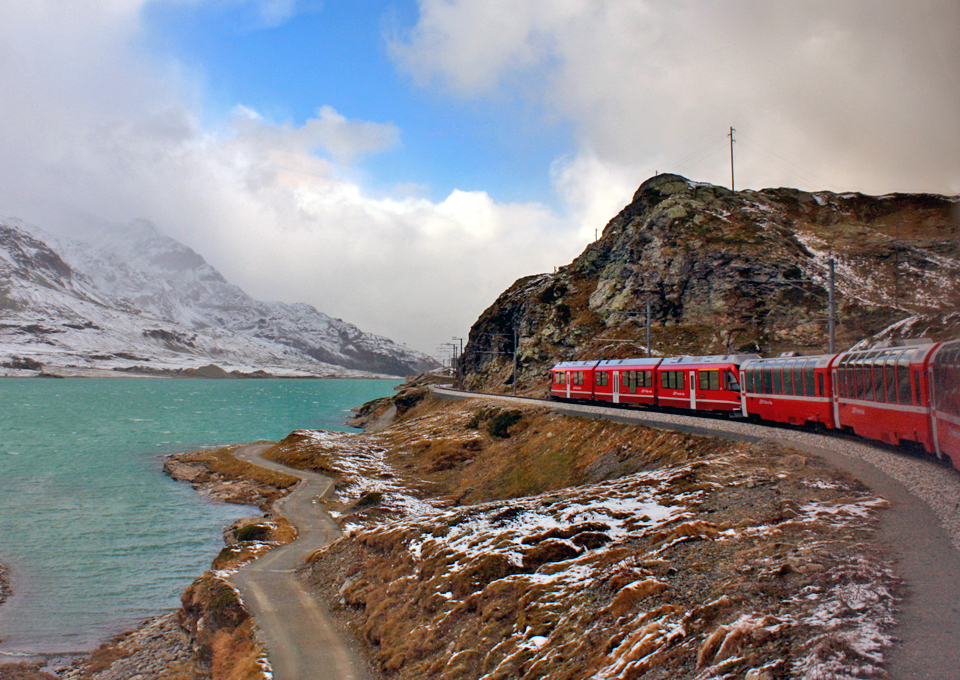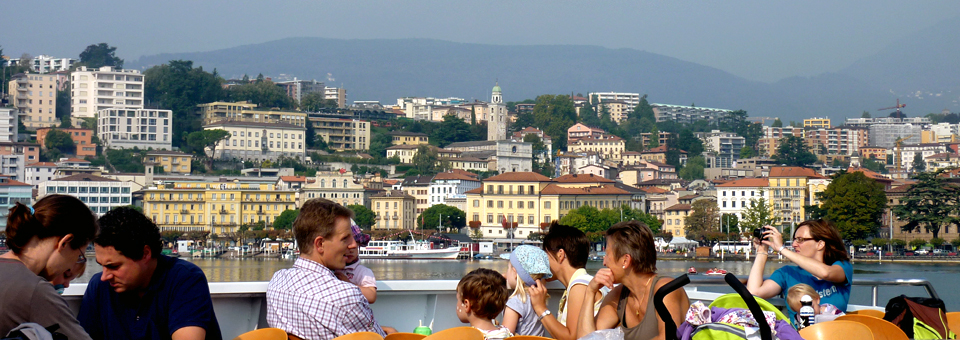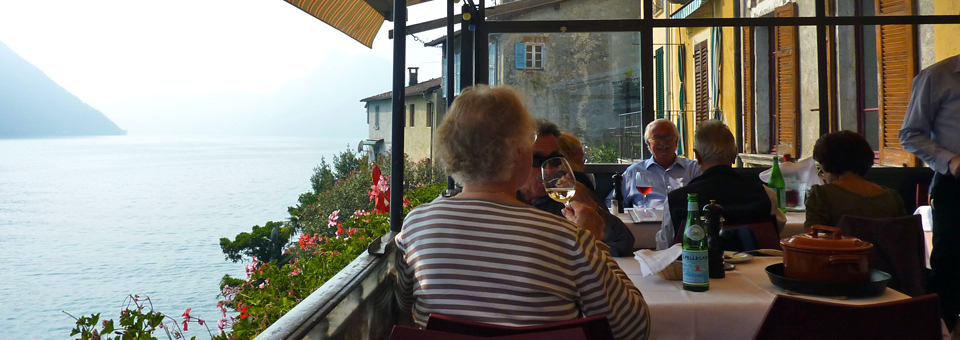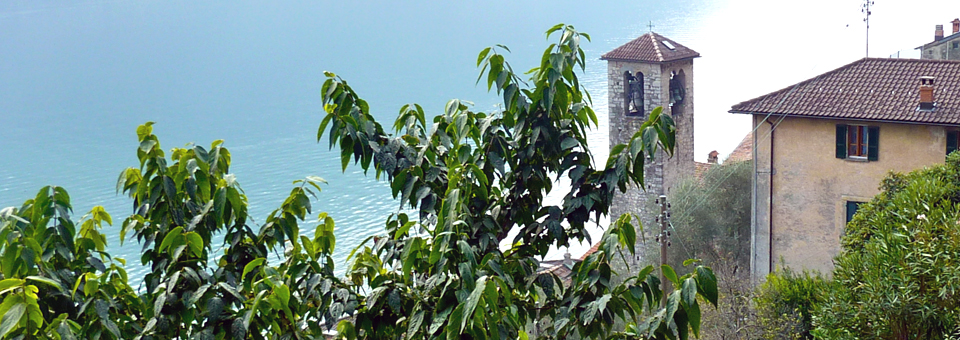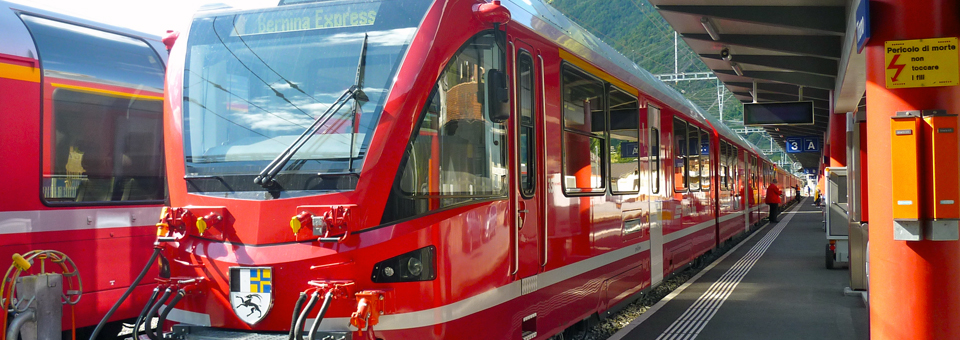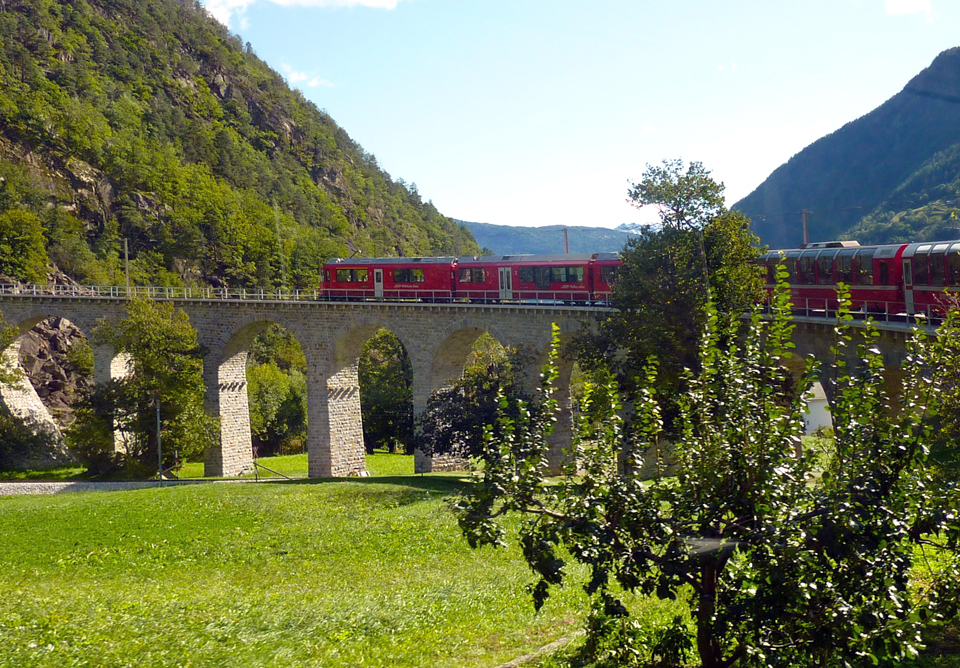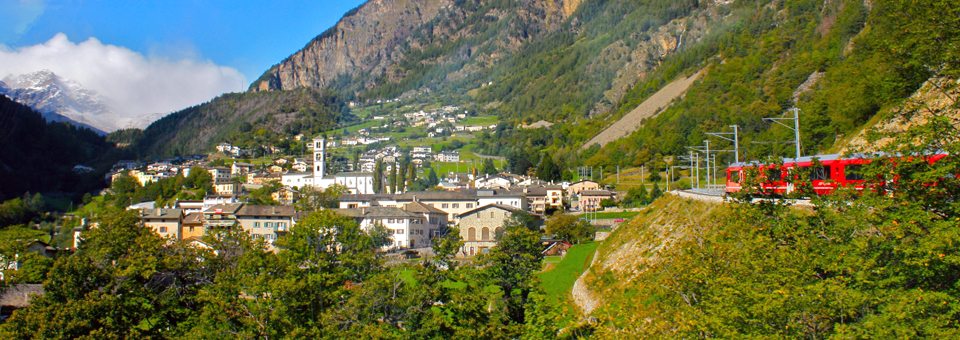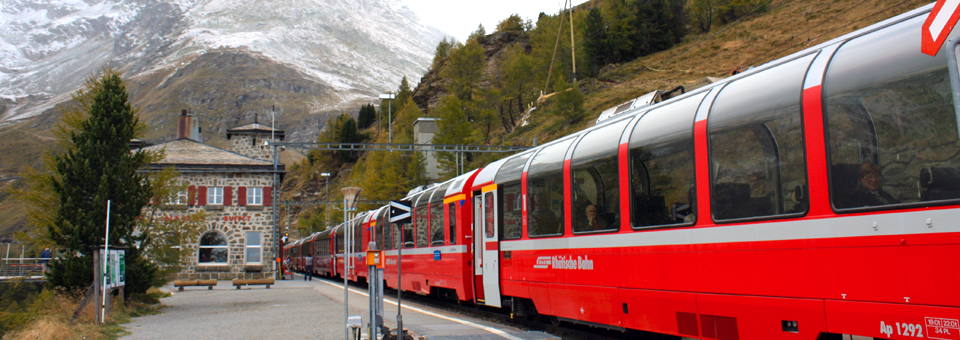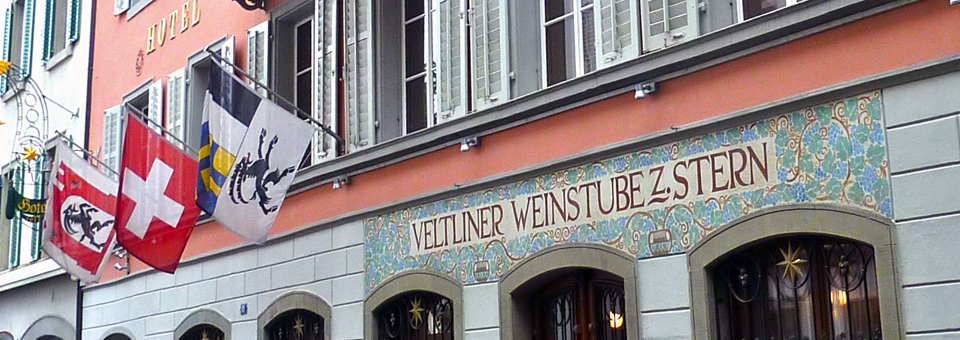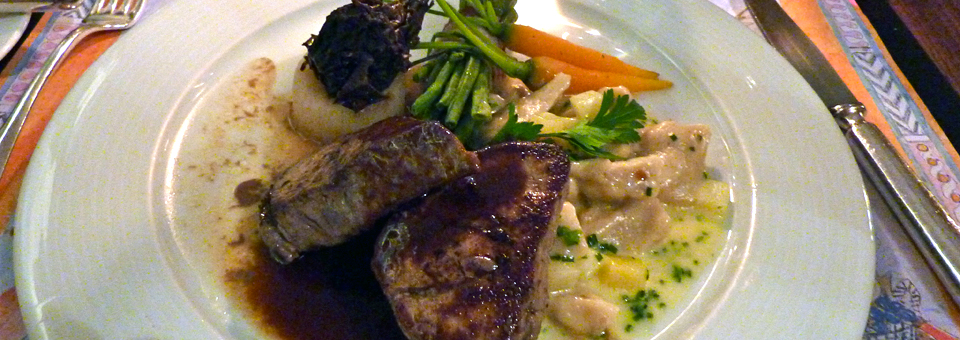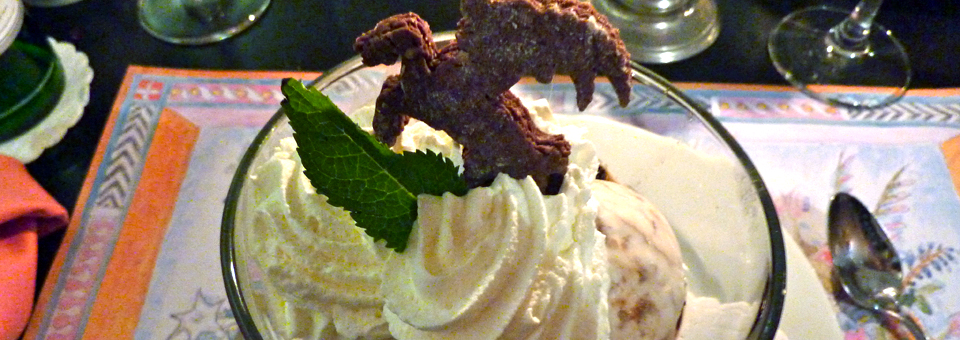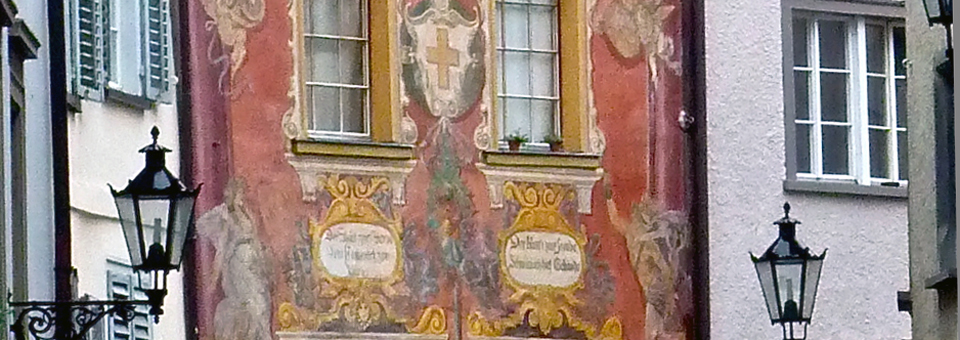From Palm Trees to Glaciers: The Bernina Express
As with each of our visits to Switzerland, we designed our trip around one of Switzerland’s scenic train rides. This time we chose the Bernina Express, the highest mountain railway in the Alps. The train maneuvers up mountains without the use of tooth-wheel mechanism, crossing the Alps and traveling through a spectacular landscape ranging from glaciers to palm trees. In 2008, the line between Thusis and Tirano was designated a World Heritage Site.
Ticino: dolce far niente
We validated our Swiss Pass at the train station right across the street from Zurich’s airport and in moments were headed for Lugano, south of the Alps, in the Italian-speaking Swiss canton of Ticino. This popular tourist destination on a lake by the same name is Switzerland’s third-largest financial center and was the start of our Bernina Express experience.
We arrived a few days early to enjoy the Mediterranean climate and experience “dolce far niente”, a blissful idleness, after our travels. We wandered through the historic part of the city, browsed the designer and gourmet shops along Via Nassa and Via Pessina, stopped at museums, art galleries, and historic churches, and walked along the lakeside promenade beneath linden and chestnut trees.
With more time, we would also have taken the funicular up Monte Brè, but found a great city view from the terrace of the Cathedral of San Lorenzo, enlarged after the epidemic in thanks to the Virgin, redone in Baroque in the 17th century, and now under extensive renovation. It is believed that a church has existed here since the 5th century.
Most fascinating of all was the church of Santa Maria degli Angioli, a simple structure built by Lake Lugano in 1499 for Franciscan monks. Plague victims were brought here and after the epidemic the walls were hammered to roughen the surface so that a disinfecting coat of lime would adhere. When the lime was removed centuries later, intact early Renaissance masterpieces were revealed, albeit with a pitted appearance from this treatment. These treasures include frescoes by Bernadino Luini, pupil of Leonardo, born near Lake Maggiore around 1480.
Our boat cruise–included with the Swiss Pass— took us to Gandria, population 200, where we enjoyed a lunch of lake perch and Ticino merlot on Ristorante Antico’s lakeside balcony. Once isolated, it was connected to both Lugano and Italy in 1935 by a road and tunnels.
Gandria was once known for olive oil, silk, and smuggling. The boat makes another stop across the lake at the Museum of Swiss Customs, right by the border with Italy.
We walked Gandria’s narrow labyrinth of cobbled lanes and climbed flights of stairs that scale the steep lakefront slope, passing a large stone, Sasso della Predescia, carved by early Celtic inhabitants, presumably for religious purposes.
We continued to the medieval belfry and baroque interior of the 16th century Church of San Vigilio. It was constructed by Medieval Lombard master stoneworkers known as maestri comacini who had worked for the King of Spain and returned to the village in their later years. The painting behind the altar of St. Virgilio being martyred is by the Torricelli brothers .
The hillside Olive Tree Path from Gandria to Castagnola is marked with 18 panels describing the olive tree’s history, botany, cultivation, and products. It leads back toward Lugano’s Parco Civico, the lakeshore promenade and statue of Swiss hero William Tell, and the flora and Ticinese sculpture of Belvedere Gardens.
The next morning we departed for our three hour bus ride along Lake Como and the Veltlin region. A baby on board laughed heartily when the AH-OOO-GAH horn sounded on the approach to villages with streets so narrow we thought we’d scrape the sides. We stopped in Sorico, one of the Mediterranean-style Lombardy villages along Lake Como, for a break at a little ristorante and pizzeria. We continued past hillside villages and vineyards on the sunny slopes of the Veltlin valley, renowned for its fine wines.
With about an hour in Tirano between the bus and train, we were glad to have brought along some Euros. There was time to shop, sip an espresso, or relax on the piazza at a spaghetteria, Pizzeria, or gelateria.
For most travel second class cars, though generally more crowded, are fine, but for this scenic adventure, the first class observation cars are worth the premium for the panoramic views. We had plenty of room to walk around and snap photographs of some of the most spectacular scenery in the world.
)
The Bernina Express links southern and northern Europe in a winding pathway that is a masterpiece of engineering–all without the use of cogwheels. It is a synergy of technology and nature designed to harmonize with the landscape, and is the third railway in the world to be designated a “universally outstanding” UNESCO World Heritage route. Seat reservations are mandatory.
It travels the trilingual–German, Italian, and Romansch– canton of Graubünden, Switzerland’s #1 vacation destination, and part of the Swiss Confederation since 1803.
There are 55 tunnels, some spiraling through mountains, 196 bridges, steep inclines, deep Alpine valleys, viaducts winding high above gorges, hairpin turns, charming alpine villages, stone farmhouses, castles, grazing cows, Swiss heritage sites, majestic snow-capped mountains, gushing waterfalls and streams, dense forests, and alpine glaciers. Brusio’s circular viaduct–the only one in the world– was just the beginning of our adventures in altitude.
The landscape and weather changed dramatically with elevation during our afternoon excursion. We began 1408’ above sea level with sunshine and 80˚-plus temperatures in palm-treed Tirano. It was a treeless alpine tundra on the nearly 7400’ high Ospizio Bernina, at the Bernina Pass, the highest point on our trip, and it snowed at well below freezing temperatures in Kloster. We stopped at the famous Alp Grüm station, which is surrounded by the Palü Glacier and Lake Palü, and disembarked to take some photographs in the howling wind.
The Albula and Bernina engines use a different electric current and are changed in Pontracina. Since the opening of the Albula Railway in 1904 and Bernina in 1910 this Engadine area, which includes St. Moritz, has been renowned for mountaineering and skiing.
We passed Samedan, home to Europe’s highest airport and headed for more spiral tunnels, viaducts, bridges and the 3.6 mile long Albula tunnel, at nearly 6,000’ the highest Alpine tunnel on any mainline railway .
Crossing the 450’ landmark Landwasser Viaduct with its 300’ arches, was like riding into an iconic photograph. We followed the Albula River and the Rhine past an area with Europe’s largest density of castles to Chur (pronounced koor), Graubünden’s capital and the oldest town in Switzerland. A transportation hub, now and historically, there are archaeological finds going back to 11,000BC.
Chur enjoys 322 days of sunshine a year, but it was a rainy day when we arrived. It was a short walk past the shops and restaurants on Bahnhofstrasse to the Hotel Stern, one of our favorite Swiss hotels, owner-operated and and a documented inn since 1677. If you like, the hotel will pick you up in its 1933 vintage limousine. Located in the historic Old Town, it has wood paneling that retains the scent of the forest, warm and welcoming service, and a classic Grisonian decor. It’s the perfect place to relax. James Fenimore Cooper is but one of the notable guests.
We were pleased to have a dinner reservation since the hotel’s restaurant fills quickly with guests and locals. Waitresses in dirndls serve scrumptious and artfully presented international and classic Swiss cuisine. We opted for Bündnerfleisch, which included an air-dried beef, prosciutto from the Grisons, Engadine air-dried sausage, and alpine cheese. We also tried the Chur Councilman’s Plate–veal and beef filets with Gran Alpin bizzochels, braised apple, and dried pear.
It was followed by ice cream, one with chestnuts and a warm caramel sauce, the other topped with dried plums marinated in plum brandy, each adorned with a cookie shaped like an ibex, the symbol of the canton.
On Saturdays regional farmers hold a food market in the Old Town. There were cheeses and sausages, fruits, vegetables, and breads–many organic– and ideal makings of a picnic. The colorfully painted historic homes were marked with dates of construction and renovation. Shops had descriptive ironwork signs.
Feminist icon Angelika Kauffmann, born in Chur in 1741, was one of most popular painters of her time. A plaque marks house at 57 Reichsgasse. Many of her narrative paintings and portraits may be seen at the Museum of Art. The Rhaetian Museum and Natural History Museum are also worthy stops.
Chur was a Prince-Bishopric, ruled by the rich and powerful and endorsed by the Holy Roman Emperors. With the Reformation, the people’s Catholic church, Kirche St. Martin became Protestant. Its tower, once inhabited by a caretaker who sounded a trumpet if he spotted a fire, has a clock second in size only to the one in Zurich.
After the Reformation, the well-connected Prince-Bishop retained his walled 12th century “mini-Vatican” with its cathedral and palace, army, loyal followers and religious elite. The present Bishop of Chur lives in the palace and controls a diocese than includes Graubünden, central Switzerland, and Zurich.
Heidiland, named for the fictional character in the popular novel by Swiss author Johanna Spyri, is nearby with a Heidi-themed village and trails.
A Swiss pass is a ticket to travel wherever you please in Switzerland’s twenty-six cantons. Plan an adventure or go where your mood takes you. From bustling cities to fairytale villages, glaciers to palm trees, Switzerland delivers an extraordinary experience.
Switzerland is only about the size of Vermont and New Hampshire combined, but offers a vast range of experiences.

